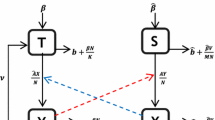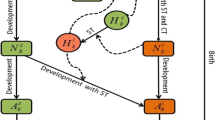Abstract
Recent increases in reported outbreaks of tick-borne diseases have led to increased interest in understanding and controlling epidemics involving these transmission vectors. Mathematical disease models typically assume constant population size and spatial homogeneity. For tick-borne diseases, these assumptions are not always valid. The disease model presented here incorporates non-constant population sizes and spatial heterogeneity utilizing a system of differential equations that may be applied to a variety of spatial patches. We present analytical results for the one patch version and find parameter restrictions under which the populations and infected densities reach equilibrium. We then numerically explore disease dynamics when parameters are allowed to vary spatially and temporally and consider the effectiveness of various tick-control strategies.
Similar content being viewed by others
References
Anderson, B.E., Sims, K.G., Olson, J.G., Childs, J.E., Piesman, J.F., Happ, C.M., Maupin, G.O., Johnson, B.J.B., 1993. Amblyomma americanum: a potential vector of human ehrlichiosis. Am J. Trop. Med. Hyg. 49, 239–244.
Anderson, B.E., Sumner, J.W., Dawson, J.E., Tzianabos, T., Greene, C.R., Olson, J.G., Fishbein, D.B., Olsen-Rasmussen, M., Holloway, B.P., George, E.H., Azad, A.F., 1992. Detection of the etiologic agent of human ehrlichiosis by polymerase chain reaction. J. Clin. Microbiol. 30, 775–780.
Awerbuch, T.E., Sandberg, S., 1995. Trends and oscillations in tick population dynamics. J. Theor. Biol. 175, 511–516.
Barbour, A.G., 1996. Lyme Disease: The Cause, The Cure, The Controversy. John Hopkins University Press, Baltimore, Maryland.
Brauer, F., Nohel, J.A., 1969. The Qualitative Theory of Ordinary Differential Equations. W. A. Benjamin, Inc., New York.
CDC, 1997. Demographic differences in notifiable infectious disease morbidity. MMWR 46, 637–641.
Davidson, W.R., Siefken, D.A., Creekmore, L.H., 1994a. Influence of annual and biennial prescribed burning during March on the abundance of Amblyomma americanum (Acari: Ixodidae) in central Georgia. J. Med. Entomol. 31, 72–81.
Davidson, W.R., Siefken, D.A., Creekmore, L.H., 1994b. Seasonal and annual abundance of Amblyomma americanum (Acari: Ixodidae) in central Georgia. J. Med. Entomol. 31, 67–71.
Dawson, J.E., Childs, J.E., Biggie, K.L., Moore, C., Stallknecht, D., Shaddock, J., Bouseman, J., Hofmeister, E., Olson, J.G., 1994. White-tailed deer as a potential reservoir of Ehrlichia spp. J. Wildl. Dis. 30, 162–168.
Des Vignes, F., Levin, M.L., Fish, D., 1999. Comparative vector competence of dermacentor variabilis and ixodes scapularis (acari: Ixodidae) for the agent of human granulocytic ehrlichiosis. J. Med. Entomol. 36, 182–185.
Ewing, S.A., Dawson, J.E., Kocan, A.A., Barker, R.W., Warner, C.K., Panciera, R.J., Fox, J.C., Kocan, K.M., Blouin, E.F., 1995. Experimental transmission of Ehrlichia chaffeensis (Rickettsiales: Ehrlichieae) among white-tailed deer by Amblyomma americanum (Acari: Ixodidae). J. Med. Entomol. 32, 368–374.
Fitzgibbon, W.E., Parrott, M.E., Webb, G.F., 1996. A diffusive epidemic model for a host-vector system. In: Martelli, M., Cooke, K., Cumberbatch, E., Tang, B., Thieme, H. (Eds.), Differential Equations and Applications to Biology and Industry. World Scientific Press, Singapore, pp. 401–408.
Gerhardt, R.R., Lohmeyer, K.H., Marsland, E.J., Paulsen, D.J., 1998. Seasonal abundance of the free-living stages of the lone star tick (Ambloymma americanum) in Cumberland County, Tennessee. J. Tenn. Acad. Sci. 73, 100–103.
Ghosh, M., Pugliese, A., 2004. Seasonal population dynamics of ticks, and its influence on infection transmission: A semi-discrete approach. Bull. Math. Biol. 66, 1659–1684.
Haile, D.G., Mount, G.A., 1987. Computer simulation of population dynamics of the lone star tick, Amblyomma americanum (Acari: Ixodidae). J. Med. Entomol. 24, 356–369.
Lockhart, J.M., Davidson, W.R., Dawson, J.E., Stallknecht, D.E., 1995. Temporal association of Amblyomma americanum with the presence of Ehrlichia chaffeensis reactive antibodies in white-tailed deer. J. Wildl. Dis. 31, 119–124.
Lockhart, J.M., Davidson, W.R., Stallknecht, D.E., Dawson, J.E., 1996. Site-specific geographic association between Amblyomma americanum (Acari: Ixodidae) infestations and Ehrlichia chaffeensis-reactive (Rickettsiales: Ehrlichieae) antibodies in white-tailed deer. J. Med. Entomol. 33, 153–158.
Lockhart, J.M., Davidson, W.R., Stallknecht, D.E., Dawson, J.E., Howerth, E.W., 1997. Isolation of Ehrlichia chaffeensis from wild white-tailed deer (Odocoileus virginianus) confirms their role as natural reservoir hosts. J. Clin. Microbiol. 35, 1681–1686.
LoGiudice, K., Ostfeld, R.S., Schmidt, K.A., Keesing, F., 2003. The ecology of infectious disease: Effects of host diversity and community composition on lyme disease risk. Proc. Natl. Acad. Sci. 100, 567–571.
Maeda, K., Markowitz, N., Hawley, R.C., Ristic, M., Cox, D., McDade, J.E., 1987. Human infections with Ehrlichia canis, a leukocyctic ricksettsia. New Engl. J. Med. 316, 853–836.
Marsland, E.J., 1997. Tick control and monitoring of tick transmitted diseases in Eastern Tennessee. Master’s thesis, University of Tennessee.
McQuiston, J.H., Paddock, C.D., Holman, R.C., Childs, J.E., 1999. The human ehrlichioses in the united states. Emerg. Infect. Dis. 5, 635–642.
Mount, G.A., Haile, D.G., 1989. Computer simulation of population dynamics of the american dog tick (Acari: Ixodidea). J. Med. Entomol. 26, 60–76.
Mount, G.A., Haile, D.G., Barnard, D.R., Daniels, E., 1993. New version of LSTSIM for computer simulation of Amblyomma americanum (Acari: Ixodidae) population dynamics. J. Med. Entomol. 30, 843–857.
Mount, G.A., Haile, D.G., Daniels, E., 1997a. Simulation of blacklegged tick (Acari: Ixodidea) population dynamics and transmission of borrelia burgdorferi. J. Med. Entomol. 34, 461–484.
Mount, G.A., Haile, D.G., Daniels, E., 1997b. Simulation of management strategies for the blacklegged tick (Acari: Ixodidea) and the Lyme disease spirochete, borrelia burgdorferi. J. Med. Entomol. 90, 672–683.
Mount, G.A., Haile, D.G., Davey, R.B., Cooksey, L.M., 1991. Computer simulation of boophilus cattle tick (Acari: Ixodidea) population dynamics. J. Med. Entomol. 28, 223–240.
Paddock, C.D., Childs, J.E., 2003. Ehrlichia chaffeensis: A prototypical emerging pathogen. Clin. Microbiol. Rev. 16, 37–64.
Pound, J.M., Miller, J.A., George, J.E., Oehler, D.D., Harmel, D.E., 1996. Systemic treatment of white-tailed deer with Ivermectin-medicated bait to control free-living populations of lone star ticks (Acari: Ixodidae). J. Med. Entomol. 33, 385–394.
Press, W.H., Flannery, B.P., Teukolsky, S.A., Vetterling, W.T., 1988. Numerical Recipes in C. Cambridge University Press, Cambridge.
Radcliffe, J., Rass, L., 1984. The spatial spread and final size of models for the deterministic host-vector epidemic. Math. Biosci. 70, 123–146.
Radcliffe, J., Rass, L., 1985. The rate of spread of infection in models for the deterministic host-vector epidemic. Math. Biosci. 74, 257–273.
Randolph, S., 1999. Epidemiological uses of a population model for the tick Rhipicephalus appendiculatus. Trop. Med. Int. Health 4, A34–A42.
Richter, D., Spielman, A., Komar, N., Matuschka, F.-R., 2000. Competence of american robins as reservoir hosts for lyme disease spirochetes. Emerg. Infect. Dis. 6, 133–138.
Sandberg, S., Awerbuch, T.E., Spielman, A., 1992. A comprehensive multiple matrix model representing the life cycle of the tick that transmits the age of Lyme disease. J. Theor. Biol. 157, 203–220.
Schulze, T.L., Jordan, R.A., Hung, R.W., 2001. Effects of selected meteorological factors on diurnal questing of ixodes scapularis and amblyomma americanum (acari: Ixodidade). J. Med. Entomol. 38, 318–324.
Sonenshine, D.E., Mather, T.N., 1994. Ecological Dynamics of Tick-Borne Zoonoses. Oxford University Press, Oxford.
Standaert, S.M., Dawson, J.E., Schaffner, W., Childs, J.E., Biggie, K.L., Singleton, J., Gerhardt, R.R., Knight, M.L., Hutcheson, R.J., 1995. Ehrlichiosis in a golf-oriented retirement community. N. Engl. J. Med. 333, 420–425.
University of Rhode Island Tick Research Laboratory, 2003. Ehrlichiosis. Http://www.riaes.org/resources/ticklab/ehrlich.html (Accessed 6 August 2003).
Author information
Authors and Affiliations
Corresponding author
Rights and permissions
About this article
Cite this article
Gaff, H.D., Gross, L.J. Modeling Tick-Borne Disease: A Metapopulation Model. Bull. Math. Biol. 69, 265–288 (2007). https://doi.org/10.1007/s11538-006-9125-5
Received:
Accepted:
Published:
Issue Date:
DOI: https://doi.org/10.1007/s11538-006-9125-5




